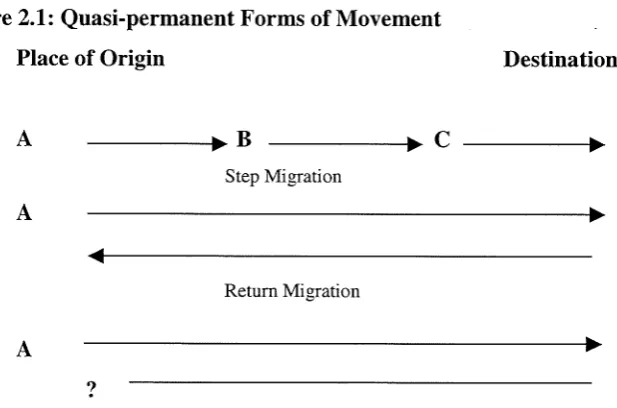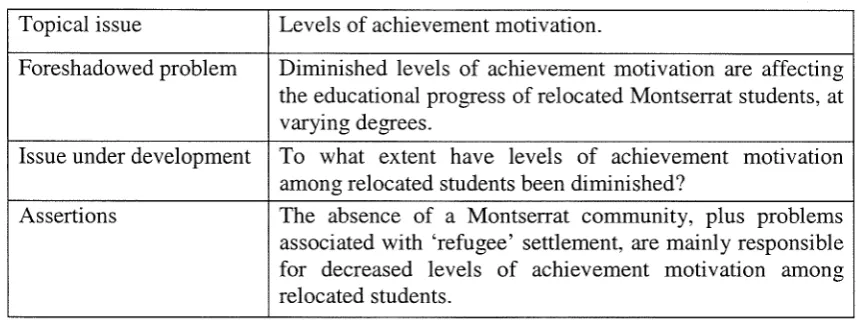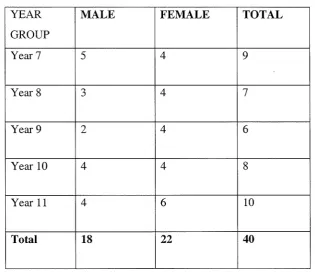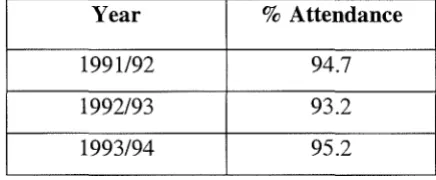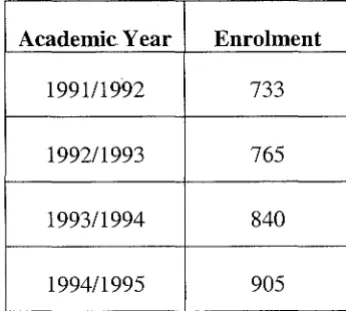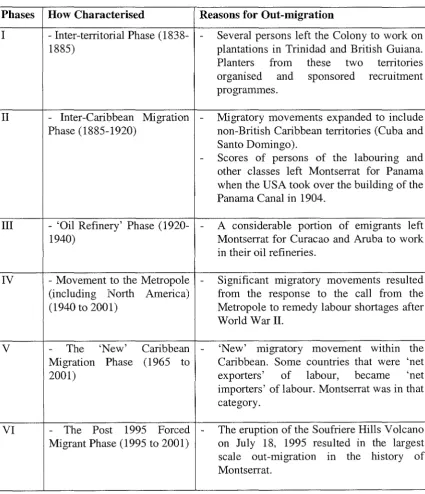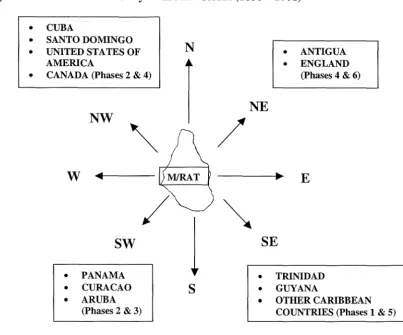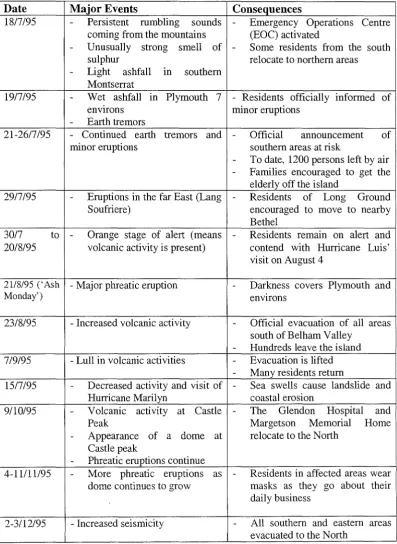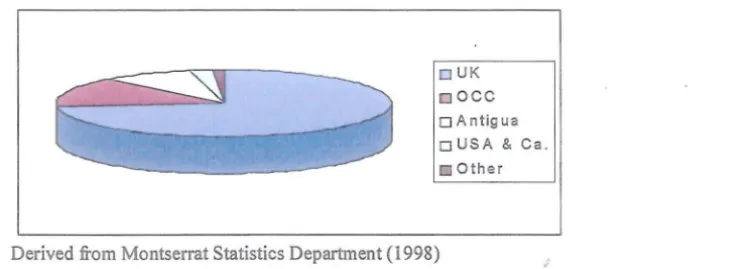Education, Migration and Identities:
Relocated Montserratian Secondary School Students
in London Schools
GERTRUDESHOTTE
Thesis submitted in fulfilment of the regulations of the University of London
for the degree of Doctor of Philosophy (PhD)
Education Foundations & Policy Studies Institute of Education, University of London
To Zamo and Zeju
Being there in good and bad times made all the difference
Abstract
This thesis explores the effects of forced migration on the educational aspirations of relocated Montserratian students in British schools. It first discusses the circumstances that influenced migration to the UK, particularly from the latter half of 1997, then compares and contrasts the educational experiences of relocated student to those of other African Caribbean and refugee migrant groups.
As a British Dependent Territory Overseas (BDTO), the way of life in Montserrat has been guided and influenced by its status as a country under British jurisdiction. Yet, Montserratians have no formal citizenship rights and have therefore been positioned in a political limbo. Expectations from home and school create a constant struggle for relocated students as they juggle a range of conflicting identities. The thesis argues that a clash of ambiguous identities has forced relocated migrants to rethink and reconstruct a sense of place, as well as redirect thoughts on educational goals and aspirations.
Fieldwork conducted with relocated students, their parents/guardians and teachers has revealed that the effects of forced migration have affected relocated students' educational aspirations. The high levels of achievement motivation that students had prior to relocation, have been greatly diminished due to several in-school and out-of-school factors. The thesis identifies the fragmentation of the Montserrat community as a major contributing factor. It also discusses the strategies that the UK-based Montserrat community groups and organisations have implemented in an effort to restore and sustain relocated students' pre-migration levels of achievement motivation, via a sense of an 'island' community.
Acknowledgements
I give thanks to Jehovah for His goodness and loving kindness (Psalms 107:1) and for giving me the strength to endure (Philippians 4: 13)
It was impossible for me to conduct this research without inheriting an extensive list of persons to whom I am deeply indebted. These persons, who are too many to catalogue, have all made significant contributions to this study, albeit of varying kinds. I am acutely aware of the fact that simply conveying thanks to contributors via this 'acknowledgement' is an inadequate expression of gratitude. However, I am compelled to mention the persons named below.
My supervisors, Dr Elaine Unterhalter and Crispin Jones, nurtured me and this study -from planning through to completion stage by providing shrewd, crucial and decisive commentary. Their resourceful support and practical encouragement often extended beyond the academic sphere. There are many instances that I can recall, but I wish to make reference to this particular occasion - the second term of the 2000/2001 academic year, which was a particularly difficult and challenging time for me. For such steadfast co-operation and kind enduring assistance, I am extremely grateful.
Embarking on this exploratory study has proven to be a more intricate assignment than I had anticipated. I gained useful insights from persons who offered helpful suggestions as the study progressed. To this end, I am especially thankful to Professor Jagdish Gundara, Dr Christopher Williams, Dr Sheila Aikman, Dr Adrien Ngudiankama, and Dr Christina Tsai, for whom 'dropping in' was never a problem. In this regard, I express too sincere appreciation to Janice Panton MBE and the administrative assistant at the MGUKO and Lazelle Howes and staff at the MCST.
It would be remiss of me if I did not extend heartfelt gratitude to the British Council for sponsoring the entire study. Sincere thanks are also due to the administrative staff of the former EID (Susan Karney and Kamala Usmani), the now LEID (Ann Rolands and Michael Broderick), Patricia Kelly and Alice Hensfield (CLC) who also played a recognisable function in this study. I gratefully appreciate their unswerving support and proficient assistance. Special thanks are also extended to other administrative personnel: To Rajee Rajagopalan, Dr Loreto Loughran and Jack Peffers of International Development Section Registry, Bridie Woods and Denise Walker-Hutchinson of Students Welfare and Accommodation Office, Wendy Barber and staff, particularly Julia Bacon and Jenny Phillips, of Research Degrees and Associateships Section and Marcel Lam-Hing and Carrie Marshall of the JAH management team.
To Jenny Federicks and family I owe an exceptional debt of gratitude for not only adopting me in their family circle but also for being 'the friends indeed'. A similar sense of indebtedness is due to Frank & Shelly James, Peter Abraham and Ira Tchoupe-Edwards for their untiring assurance and unwavering devotion during very stressful and tough times.
To the relocated students, their parents/guardians, their teachers, education officials, social workers, parental outreach workers and fellow citizens of the relocated and first-wave Montserrat community, I convey an incomparable 'thank you'. Without their ready participation, kind encouragement, willing and loyal co-operation and committed assistance, the completion of this thesis would not have been realised.
Table of Contents
Abstract
Acknowledgements
Table of Contents
List of Tables
List of Figures
List of Appendices
Abbreviations & Acronyms ... .
Glossary
Map - The Caribbean Islands
Map of Montserrat - Pre 1995
Map of Montserrat - Post 1995
Chapter 1: Introduction ... . Introduction ... . Historical Context of the Research
Complaints and concerns Aims and Research Questions Significance of the Study
The Structure of the Thesis ... .
Chapter 2: Migration and Identity: A Discussion of Literature ... . Introduction ... . Migration: The Panacea for a Better Life? ... . Identity: Congruence of Self-definition, Self-esteem
and Educational Success ... . Conclusion ... .
Chapter 3: Approaches and Methods Used in the Research ... . Introduction ... . Methodological Approaches ... . Methods associated with two paradigms ... . The nature of qualitative research ... . Subjectivity in qualitative research ... . Why a qualitative approach ... . Philosophical and intellectual assumptions ... . Case Study Design and Supporting Perspectives ... .
Methods of Data Collection and Analysis ... . Piloting the study ... . Sampling, sampling parameters and the Researcher's Role .. . The Researcher's Role ... . Data collection, recording and analysis ... . Informal interviews ... . 'Formal' interviews
Observations ... . Personal accounts and reports ... . Data analysis ... . Verifying Data Quality ... . Internal and external validity ... . Reliability ... . The qualitative narrative ... . The Question of Power ... . Teachers and I ... . Students and I ... . Parents and I ... ' ... . My Experience as an Interviewer ... . Conclusion ... .
Chapter 4: The Emerald Isle: A Historical Account ... . Introduction and Background ... '" ... , ... . Political, Economic and Social Development. ... . Political development ... . Settlement patterns ... . Governance and status ... . The independence saga ... . Citizenship ... . Economic development ... . Social development ... . Education ... . Primary Education ... . Secondary Education ... . Culture ... . Migratory Patterns Then and Now ... . Post-Emancipation Migration ... . Post-War Migration ... . Conclusion ... .
Chapter 5: The Volcanic Crisis and Mass Migration ... . Introduction and the Nature of the Crisis ... . Volcanic Activities that Influenced Mass Migration ... . Voluntary Relocation and Assisted Passages Scheme ... . Demographic Issues ... . Post 1995 Migration Phase ... .
Disasters and Resilience ... 121
The Education Factor... 123
Schooling and Hurricane Hugo ... . Schooling during the first two years of the crisis Conclusion 123 124 128 Chapter 6: African Caribbean Students in British Schools ... 129
Introduction ... 129
Stereotypes, Visibility and Invisibility ... 130
Fighting to Pursue Educational Goals... 142
Negative School Experiences and Un met Expectations ... 145
Self-image: The Individual Factor ... 147
The Language Issue ... 154
Conclusion ... ... 159
Chapter 7: The 'Refugee' Experience of Relocated Montserratian Students ... . 161
Introduction 161 Definitions and Refugee Status ... . 162
Common Misconceptions ... . 168
Treatment of Montserrat 'Refugees' ... . 170
Trauma and Educational Experiences ... . 172
Meeting Educational Needs ... . 176
Homelessness: The Montserrat 'Refugee' Experience ... . 180
Conclusion ... . 183
Chapter 8: Achievement Motivation and Educational Success ... . 184
Introduction ... . 184
Concepts of Achievement and Achievement Motivation ... . 184
Factors that Influenced Achievement - Pre-Relocation Times 188 Post-Relocation and Achievement Motivation 192 Conclusion 203 Chapter 9: Identity, Ethnicity and School Experiences ... . 204
Introduction ... . 204
Interrelatedness: Identity and Ethnicity Explained ... . 205
Forced Migrants/Refugees and Identity ... . 206
Maintaining a Montserratian Identity in School ... . 209
Adapting and Combining Identities ... . 214
A 'Sense of Place' ... . 218
Identity and In-betweenness ... . 221
Conclusion ... . 223
Chapter 10: Home, School and Community Partnership ... . 225
Introduction ... . 225 Social Networks ... . 227"''''
The role of the churches
Reactions to Initiatives Students'reactions
Relocated parents' reactions ... . Teachers' reactions to community initiatives ... . Extent of Community Projects' Success ... . Indicators of projects' success ... . Importance of Home, School and Community Collaboration
Home-school links ... . Home-community links ... . School-community links ... '" ... , ... . Bridging the 'Rings of Security' ... . Conclusion ... .
,
Chapter 11: Reflections, Evaluation and Implications ... . Introduction ... . Reflections on Main Findings ... . In-school factors ... . Out-of-school factors ... . Other factors ... . Evaluation of the Thesis
Evaluation of the Methods
Implications, Proposals and Suggestions ... . 'Qui non proficit deficit' ... . Resilience and survival ... . Suggestions for Future Research, Policy and Practice ... . Future research ... . Future policy and practice ... . Concluding Comments ... .
Bibliography ... .
List of Tables
Table 3.1: Issue Development for the Case Study of Relocated
Montserrat Students . . . 61
Table 3.2: Composition of Student Sample . . . .. . . 65
Table 4.1: Average % Attendance - Primary Schools Montserrat
(1991-1994) ... , ... '" ... ... ... ... ... ... ... 100
Table 4.2: Increase in Enrolment at The Montserrat Secondary School
(1991-1995) ... , ... ... ... ... ... ... ... ... ... ... ... 102
Table 4.3: Phases of Migratory Movements from Montserrat
(1838 - 2001) ... ... 106
Table 5.1: Major Volcanic Activities - July 1995 to July 1996 111
Table 5.2: The Effects of Major Volcanic Activities on Schooling:
18 July 1995-31 July 1996 ... 127
Table 6.1: Nationality and Friendship Choices 151
List of Figures
Figure 4.1: Distribution of Employment in Montserrat - 1973 92
Figure 4.2: Patterns of Mobility from Montserrat (1838 - 2001) 107
Figure 5.1: Departures to Specific Destinations by Montserrat Migrants
-July 1995 - -July 1998 ... 118
Figure 7.1: The 'Web' of Relationships and Connections to
Other People and Social Structures . . . .. . . .. 167
Figure 7.2: The 'Web' of Relationships and Connections to Other People and Social Structures of Many Refugees
Figure 8.1: Model of Factors that Influenced Pre-Forced Migration
167
Achievement Motivation among Montserratian Students 189
Figure 8.2: Kerckhoff's Model of the Education Attainment Process 193
Figure 8.3: Factors that Helped to Sustain Relocated Montserratian Students'
Achievement Motivation. . . .. 194
Figure 8.4: Factors that Contributed to a Decrease in Relocated Montserratian
Students' Achievement Motivation ... 198 Figure 10.1: Effects of Forced Migration on Relocated Montserratian Students'
Achievement Motivation ... ... 226
Figure 10.2: A Home-School Based Model of Success 244
List of Appendices
Appendix I: Main Questions Used in the Students' Interview Appendix II: Main Questions Used in the Parents' Interview Appendix III: Main Questions Used in the Teachers' Interview
Appendix IV: 'Location' Information: Form Used to Collect Details from
290 293 296
Potential Research Participants . . . ... 298
Appendix V: Observation Schedule Used in Schools
Appendix VI: Montserrat Volcanic Risk Map - October 1996 Appendix VII: Montserrat Volcanic Risk Map - February 1997 Appendix VIII: Montserrat Volcanic Risk Map - June 1997
299 302 303 304 Appendix IX: Montserrat Volcanic Risk Map - July 1997 ... ... ... ... ... 305 Appendix X: Montserrat Volcanic Risk Map - September 1997 306 Appendix XI: Summary of the London Forum Education Workshops I, II & III
-26 June, 20 July & 24 August 1999 ... 307
Appendix XII: Summary of Recommendations Made at MCST Workshop
-26 February 2000 . . . ... 308
Abbreviations
&
Acronyms
ACER - Australian Council for Educational Research
APP - Assisted Passages Programme
ARVRS - Assisted Regional Voluntary Relocation Scheme
BBC - British Broadcasting Corporation
BDT - British Dependent Territory
BDTO - British Dependent Territory Overseas
BOT - British Overseas Territories
BOTC - British Overseas Territories Citizen
BOTO - British Overseas Territories Overseas
CARl COM - Caribbean Community CARIFESTA - Caribbean Festival
CDERA - Caribbean Disaster Emergency Response Agency
CEE - Common Entrance Examination
CEN - Community Empowerment Network
CM - Chief Minister
CPC - Caribbean Publishing Company
CRC - Convention on the Rights of the Child
CSE - Certificate in Secondary Education
CTO - Caribbean Tourism Organisation
CXC - Caribbean Examinations Council
EAL - English as an Additional Language
ELR - Exceptional Leave to Remain
EMAG - Ethnic Minority Achievement Grant
EOC - Emergency Operation Centre
ESL - English as a Second Language
FCO - Foreign and Commonwealth Office
FMR - Forced Migration Review
GSE - General Secondary Education
GCSE - General Certificate in Secondary Education
GoM - Government of Montserrat
lIMA - Hackney Montserrat Association
IIMG - Her Majesty's Government
ICHRP - International Council on Human Rights Policy
ICS - Institute for Commonwealth Studies
ILR - Indefinite Leave to Remain
JMSS - Josina Machel Supplementary School
JSS - Junior Secondary School
KMA - Keep Montserrat Alive
KPS - Kinsale Primary School
LDCs - Less Developed Countries
LEA - Local Education Authority
MAC 89 - Montserrat Aid Committee
MAPS-Montserrat Assisted Passages Scheme
MCPP - Montserrat Country Policy Plan
MGUKO - Montserrat Government United Kingdom Office
MID - Montserrat Immigration Department
MoE - Ministry of Education
MOPPA - Montserrat Overseas Progressive Peoples Alliance
MP - Member of Parliament
MSD - Montserrat Statistics Department
MSS - Montserrat Secondary School
MTC - Montserrat Technical College
MVEO - Montserrat Voluntary Evacuation Office
MVO - Montserrat Volcano Observatory
ODA - Overseas Development Administration
OECS - Organisation of Eastern Caribbean States
OFSTED - Office for Standards in Education
PLM - Peoples' Liberation Movement
PRU - Pupils' Referral Unit
PTA - Parent Teachers' Association
PTSD - Post Traumatic Stress Disorder
PVP - Pre-Vocational Programme
RMDF - Royal Montserrat Defence Force
RMPF - Royal Montserrat Police Force
RSP - Refugees Studies Programme
SEN - Special Education Network
TES - Times Education Supplement
UNESCO - United Nations Educational Scientific and Cultural Organisation
UNHCR - United Nations High Commission for Refugees
UK - United Kingdom
UKCOSA - United Kingdom Committee for Overseas Students' Affairs
USA - United States of America
UWI - University of the West Indies
YES - Voluntary Evacuation Scheme
WCEFA - World Conference on Education For All
WI - West Indies
Ash:
'Centres':
Danger zone:
Glossary
volcanic particles less than 4 mm in diameter.
The accommodation provided by the Ministry of Education, Montserrat, to conduct classes in the safe zone after the April 1996 official evacuation from all areas South of Belham Valley. The 'centres' were a combination of private buildings and tents.
Restricted area due to high levels of volcanic activity. See Appendices VI -
x.
Exceptional Leave to Remain (ELR): The immigration status granted at the
Lava dome:
discretion of the Home Secretary, for 'humanitarian or administrative reasons'. Relocated Montserrat immigrants were initially granted two years ELR. Because of the ongoing volcanic crisis, from June 1, 1998, relocated immigrants were granted indefinite ELR.
Rounded, steep-sided mounds built by very viscous magma, usually either dacite or rhyolite. Such magmas are typically too viscous (resistant to flow) to move far from the vent before cooling and crystallizing. Domes may consist of one or more individual lava flows. Although lava domes are built by non-explosive eruptions of viscous lava, domes can generate deadly pyroclastic flows.
Levels in the Montserrat School System: There are four levels: (i) pre-primary or nursery (1 to 5 years); (ii) primary (5 to 11+); (iii) secondary (11+ to 16); and (iv) tertiary or post secondary.
Montserrat Community Support Trust: The Montserrat Project was renamed the Montserrat Community Support Trust (a registered charity) in February 1999. The focus became consolidation, education, community development, training and employment.
Montserrat Government United Kingdom Office: Office set up in October 1998 to oversee public relations between the Government of Montserrat and Her Majesty's Government.
Pyroclastic flow: High-speed avalanches of hot ash, rock fragments, and gas that move down the sides of a volcano during explosive eruptions or when the steep edge of a dome breaks apart and collapses. These pyroclastic flows, which can reach 1500 degrees F and move at 100-150 miles per hour, are capable of knocking down and burning everything in their paths.
Relocated students: Students who migrated from Montserrat to the UK after the volcanic crisis began on 18 July 1995.
Relocated parents: Parents of the relocated students, who migrated from Montserrat to the UK after the volcanic crisis began on 18 July 1995.
Safe zone: The area considered to be free from 'danger' of volcanic activities. See Appendices VI -X.
'Shelterees': Persons who were housed in the 'shelters' as a result of internal displacement.
'Shelters': The accommodation in churches and school buildings in the safe zone provided by the Emergency Operation Centre (EOC), for persons who were internally displaced because of the volcanic activities.
Students: In this study 'students' refer to all children of school-going age. In Montserrat, children at all levels of the school system are referred to as students.
The London Forum: An association of Montserrat community action groups, co-ordinated by Janice Panton, Officer at MGUKO, representing members of the following associations:
• Hackney Montserrat Association (HMA); • Keep Montserrat Alive (KMA);
• Montserrat Action Committee '89 (MAC'89);
• Montserrat Overseas Progressive Peoples Alliance (MOPPA); • The Montserrat Community Support Trust (MCST).
The Montserrat Project: Established in January 1998 in London for the purpose of offering advice and support to Montserratian evacuees who had opted to settle in the United Kingdom as a result of the volcanic activity in Montserrat. It is administered by Refugee Action, a sub-organisation of The Refugee Council.
Map of the Caribbean Islands
(Location of Montserrat in Relation to its Caribbean Neighbours)
Montserrat
-
Pre 1995: Before the Soufriere Hills Volcano Erupted
Montserrat
-
Post
1995:
'Safe' and Danger Zone Division
-Northern, Daytime Entry and Exclusion Zones
Introduction
Chapter!
Introduction
[open my eyes and see our trekfrom our LITTLE BAY, Heading northwards.
A large bite of the apple, evacuating ourselves from the Promised Land to the land of promise.
[17 vain [ lookfor the ancestors of those who will return,
But [ am blinded, for [weep, [weep for them and [ weep for us who remain.
(Karney Osborne [998:95)
This thesis examines the effects of forced migration on the educational aspirations of relocated Montserratian students in London schools in the late 1990s. The factors that have affected the relocated secondary school students' educational aspirations entail 'homelessness' and the loss of the Montserrat community. Additionally, they have experienced negative aspects of fractured identities to which stereotyped ideas of teachers and fellow students in the UK have contributed. The thesis relates how the adjustment by relocated Montserratian migrants to the ever changing circumstances brought about by their forced migration has necessitated the construction of new, multiple identities. It also explains how assuming these new roles sometimes brought about identity clashes and conflicts with Montserratian cultural values that too, have impacted on relocated students' educational aspirations. This chapter outlines the historical context of this study, the rationale for researching the educational experiences of the post 1995 Montserratian migrants and the aims of the study. It details the research questions that were developed to help me to achieve these aims, the significance of the research, and the structure of the thesis.
Historical Context and Rationale for the Research
The rationale for undertaking this research has a two-fold dimension - moral and academic. Moral because of my alliance with the relocated informants, and academic because this research can add to the body of literature on forced-migrant groups.
I arrived in the UK as a post graduate students about the same time when the exodus from Montserrat to the UK began. In 1998 for my MA degree, I conducted an investigation that provided a general picture of the educational experiences of relocated students in the UK (Shotte 1998b). Embedded in the several pertinent issues that emerged from that study, were concerns about identity and community that are linked to educational achievement. This research has its genesis in that work.
My experience as a teacher at three (primary, secondary and tertiary) of the four levels in the Montserrat education system, has allowed me to build a 'special' relationship with many students, undoubtedly influenced by the milieu of a small, close-knit community. It has also afforded me countless opportunities to assist these and other students during the first critical months of the crisis. For these students, the pre-migration period was one burdened with trauma, stress and physical discomfort. My school and community experiences with the students during the volcanic crisis, coupled with a genuine concern for the students' educational and general welfare, have moved me to investigate their educational experiences in the UK, with a view to providing pertinent information to the persons who can assist them to progress. Although by legal definition (See Chapter 7), the relocated Montserrat children are not refugees, generally, they have been so labelled and thus, inadvertently have become victims of political and social circumstances that may impede their educational aspirations and progress.
Complaints and Concerns
or even Canada and the United States of America (USA) were influenced by the widely accepted notion that a 'British education is best'. Moreover, it was generally thought that the transition from the Montserrat to the British education system would have been a smooth one since Montserrat remains a British Dependent Territory (BDT), and to a large extent operates within the confines of that status.
In 2001, four years after the 1997 exodus from Montserrat, parents' high hopes and aspirations were yet to be realised. Feelings of disappointment and frustration remained common. In response to complaints, the London Forum, a Montserrat organisation, co-ordinated three education workshops during the summer of 1999 (June 26, July 20 and August 24), to address parents' concerns. This study was further influenced by the workshop reports, which revealed that students were intensely worried about their educational progress, and parents equally distressed over the depleted levels of achievement motivation among relocated students (Shotte 1999a). Achievement motivation for this study simply means the desire to succeed or achieve educationally - to accomplish something and this concept permeates the development of this study. Concepts of achievement and achievement motivation are discussed in Chapter 8.
that appeared to have been damaged through forced migration. It was this concern that prompted the research on which this thesis draws.
Aims and Research Questions
This study has three main aims. They are:
• To explore some key educational expenences of relocated Montserratian secondary school students in London schools;
• To assess the impact of these expenences on the relocated students' educational aspirations;
• To add an educational dimension to the literature on relocated Montserratian migrants' experiences in the UK.
To help me to achieve these aims, I developed a set of research questions that are directly related to the main issues to be explored. The development of the research questions for this study are grounded in Creswell's position on developing research questions for a qualitative study - a single, overarching question and several sub-questions (Creswell 1998: 106). The central question for my research is, how have reformations of identity and community among relocated Montserratians in the UK since 1995, affected relocated students' educational aspirations?
My interest in the relocated students' educational aspirations IS directly related to relocation, identity and community. This interest is born out of concern for the maintenance of cultural values, which, over the past century have helped to shape a Montserrat identity. Ingrained in these values are aspirations for educational success in a national context where education extends beyond formal schooling and embraces the totality of human potential. This brings into focus the achievement motivation issue, for the average Montserrat student's desire to succeed was also fuelled by successful participation in village and/or island community activities that have been an integral part of his/her overall educational expenences.
The sub-questions seek to explore the ways in which the participants interpret the world in which they find themselves (Cohen & Manion 1996:8). They are:
• How do relocated Montserratian students describe their educational experiences?
• How do teachers describe the educational experiences of relocated Montserratian students?
• What are relocated parents' perspe~tive of their children's educational experiences? • How do relocated Montserratian students' educational experiences compare and
contrast with those of other migrants, particularly refugees and African Caribbean students, in British schools?
By addressing the major concerns of the study, the sub-questions have expanded and illuminated the overarching question as well as the aims of the thesis.
Significance of the Study
important documentary and historical reviews in their areas. I deem an investigation into the educational aspect of the crisis as equally significant.
Researching the educational experiences of Montserratian students in British schools can provide much needed information for all interest groups in the education system. Among the many interest groups, the following beneficiaries are my primary targets: policy makers, education planners, curriculum developers, administrative and management officials, principals, headteachers and teachers, parents and students.
It should be noted that the above-named groups are not ranked in order of importance. On the contrary, the students, although listed last, should appear very high on the agenda since they are the ones who will ultimately benefit from an efficient, well-structured education system. It is not only imperative for education officials and teachers to have background information of the students' traumatic experiences prior to relocation to the UK, but also to have a sound knowledge of such students' educational past. Such information will allow teachers and.education officials to provide the necessary assistance for the students as they
'strive for excellence' in a new and 'foreign' learning environment.
One of the goals of MCST is "to enable the resettlement efforts of Montserratians and enhance their social, economical and cultural well being" (MCST 1999:5). MGUKO strives to inform national policy for the benefit of the Montserratian community (GoM 1998b). The findings of this research are intended to provide MCST and MGUKO with some of the information needed to help them to achieve their goals.
The Structure of the Thesis
Chapter Two
Migration and Identity: A Discussion of Literature
There is no sorrow above the loss of a native land (Euripides).
Introduction
The purpose of this chapter is to examine literature that frames the focal themes in this study - migration and identity.
I wish to emphasise that this study is not positioned within a specific theoretical framework for it is an issue-oriented case study (Chapter 3). However, I h~ve identified specific theoretical perspectives that helped me to understand the links between the concepts that emerged from the study. Because the main themes under discussion in this thesis are embedded in a given social context, it was problematic to pin a particular theory to a specific situation for the process of identity formation is highly responsive to the ever changing contextual socio-political and socio-economic conditions, often shaped by large migratory flows. Hence, there are shifting distinctions between individuals' patterns of behaviour in relation to new and different social structures (Sheets 1999; Liebkind 1992).
Conceptually, migration and identity are inextricably related. On the basis of studies relating to the nature of refugee adaptation and the dynamics of cultural change, it is generally acknowledged that 'settling in' and the continuous constructing and reconstructing of new identities have affect forced migrants' educational achievement (Krulfeld & Camin01994). Migration, but more so involuntary migration, inevitably brings about numerous and varied challenges, hardships and changes in migrants' lives.
But that is nature of population movements as is discussed in the next section.
Migration: The Panacea for a Better Life?
The history of these 'modern' population movements is peppered with 'voluntary' and 'involuntary' immigration, ranging from enslavement of African peoples, indenture of peoples from Asia, Ireland and so on, the 'mass migration' after 1815, especially of Europeans to the Americas, Oceania, and South and East Africa; through the displacement of peoples during the two World Wars, the labour migrations following the Second World War; to the refugees, 'asylum seekers', and the wealthy business, professional and cultural entrepreneurs traversing the globe during the 1980s and the 1990s (Brah, Hickman & Mac an GhaillI999:5).
The above statement has made clear that 'contemporary migration' has expanded to the extent where migratory flows that traditionally focused on the 'poor' labour migrant and refugees, now include the wealthy 'business-class' professional migrant, albeit to a lesser degree. Acton (1999:144) suggests that this new form of 'social migration' has evolved from international and transnational economic practices, a product of globalisation, while Brah, Hickman & Mac an Ghaill (1999:5) advance that migration is a key dimension of globalisation. Castles & Davidson (2000:8) propose a bond between globalisation and migration by suggesting that globalisation means the rapidly increasing mobility of people across national borders. They identify two phases of global migration since 1945:
(1) Post-war economic boom stimulated a large-scale labour migration to old industrial countries from less developed areas. This phase ended with the 1973 'oil crisis'.
(2) From the mid-1970s, capital investment shifted away from the old centres, and transnational production and distribution reshaped the world economy. Migratory flows at first decline and were partly reversed before growing again (Castles & Davidson 2000:55)
As will be discussed in Chapter 4, these phases resonate with different phases of migration from Montserrat (p.83).
Sassen utilises the following explanation of 'global cities' to show the relationship between globalisation and migration:
Global cities are poles of attraction for these international flows of people and capital, emphasising in particular the creation of an immigrant underclass often working in the informal economy, which is juxtaposed with a 'post-industrial' class of professionals (Sassen 1996, in Wallace 1999:185).
'new' migratory trends. These new trends, according to Castles & Davidson (2000:8) began after 1945 and gathered momentum from 1980. Their 'newness' is marked by two features: (1) their sheer scale and (2) the ethnocultural characteristics of many of the immigrants. The features are described this way:
• They affect all regions and all countries of the world simultaneously. The speed at which new ethnic minorities have emerged has confounded policy makers and undermined laws and practices concerned with integration and citizenship.
• They come from areas that are increasingly distant - not only in kilometres, but also in cultural terms. They often originate in former colonies or areas of military presence of the receiving countries: North and West Africans in France; Caribbeans, Indians, Pakistanis and Bangladeshis in Britain; Mexicans, Filipinos, Koreans and Vietnamese in the USA; and so on (Castles & Davidson 2000:9).
Such large-scale migration has affected the policies and practices of both the host country and the country of origin. For example, with regards to the host countries in European societies, Solomos & Wrench (1993:12) saw the need for governments to (1) develop policies that would tackle discrimination more effectively; (2) make links between policies on immigration and policies on social and economic issues; and (3) develop positive social policy agenda to deal with the position of both established communities and new migrants.
With regards to the country of origin, I refer specifically to the 'brain drain' issue. This concept refers to " the migration of highly skilled individuals who are trained in one country and take up residence in another" (Grubel 1994:554). Whether these highly skilled migrants are lecturers/teachers, executives, technicians or business personnel, the economic loss is great since the loss of highly skilled workers frustrate economic development -especially in small states such as the Caribbean (Mills 1997:2-5). Prospects for better· income, professional opportunities, more appealing working conditions and sociological-cultural aspects of life are identified as the dominant motives for persons with high levels of training to migrate (Grubel 1994:555). From a Caribbean perspective, I wish to add the 'foreign is better' ideology to these motives.
educational future, thus educational opportunities in Britain often served as incentives for persons to migrate (Bryan et al 1985; Stone 1981). Many migrant parents shared this view as Tomlinson noted in her work that investigated issues relating to home-school relations in a multicultural society:
Whatever the class position, educational levels and colonial backgrounds of migrant parents, they mostly share high expectations about education, and they view schools as places where children's life chances should be enhanced (Tomlinson 1984:52).
The complexity between education and migration deepens when migrants' expectations, for 'equal opportunity' or for familiar cultural and religious practices, are not met. These unmet expectations themselves raise issues regarding ethnicity. From among the many scholarly definitions of ethnicity offered by the literature, I find the following most appropriate to show the link between ethnicity, racism, culture and migration:
Ethnicity describes a sense of commonality transmitted over generations by the family and reinforced by the surrounding community. It is more than race, religion, or national and geographic origin. It involves conscious and unconscious processes that fulfil a deep psychological need for identity and historical continuity (Giordano & Giordano in Slonim 1991 :5)
Ethnicity suggests belonging to a particular group - having shared aims. I equate the notion of shared aims to two characteristics of diasporic communities: (1) the construction of common features of 'home' from which the migrants come, and (2) the collective experience of journeying and transition (Unterhalter 2000: 111).
If ethnicity transcends national and geographic origin, then a migrant takes with himlher an ethnic label that is recognised by himselflherself, other migrants and people in the host country. And if this ethnic identity is reinforced by the surrounding community, it seems reasonable to assume that the host country, which now in a sense becomes the national community, plays a significant part in determining the social boundary in which the ethnic group thrives.
'primordial' characteristics, although ingrained, can change within specific circumstances. For example, some migrants may denounce their 'citizenship by birth' and acquire another or may settle for dual nationality. Also, others may become bi-lingual or multi-lingual and thus may be in a position to shift 'allegiance' if the situation warrants it. The iatter approach is the one favoured by symbolic interactionists who view ethnic identity as fluid, situational and changeable (Lee 2001: 51). This study is mainly concerned with a priomordialist approach since there is no scope for change with regards to Montserratians' nationality and language in light of their BDTC status and their official language, English. The study therefore questions whether physical appearance facilitated or hindered the
'settling in' process, with particular reference to their educational needs.
Physical appearance as a feature of ethnicity, classifies one as belonging to a particular 'race'. Britton (1999: 135) asserts that skin colour is an essential feature of one's ethnicity and further explains that the skin colour signifier has contributed to the persistence of processes of racialisation which have negative implications for those classified as whites. Given that 'black' and 'white' were posited to be opposites, it follows that non-whites are 'black'. This dichotomous classification implies that the term 'black', which commonly defines persons of African-Caribbean origin (Britton 1999: 136), incorporates all ethnic minority groups in Britain, despite their colour of skin. Miles (1993:37) notes that post-war migrants, refugees and asylum seekers who are classified as 'blacks', are objects of racism. But it is problematic to employ such a skin colour distinction since many Asian migrants do not define themselves as 'black', nor do African Caribbean migrants view them as such. Apparently, skin colour in this context represents more than a visual characteristic for Brah (1993:196) explains that it was the 'non-whiteness' within the racism confronting the post-war immigrants that provided a common point of reference, not the various shades of skin colour.
representing a discrete identity operation (Cross Jf. et al 1999:3). For them, identity is a combination of behaviours displayed in a range of different settings. Cross et al researched the development of social and racial identity among African Americans. I deem the comparison of African Americans in the USA with African Caribbean in the UK as practical because there are striking similarities in patterns of racialised and ethnic relations within both nations (Small 1993:234). Small further explained that the US boasts the more dominant scholarship in the field of racialised and ethnic relations and the influence on researchers in England has been "pervasive and profound". This thesis examines the extent to which this "pervasive and profound" influence in patterns of racialised and ethnic relations has impacted on relocated students educational aspirations.
To return to the issue of racism, The International Council on Human Rights Policy (ICHRP) explains what it entails:
Racism is about distribution of resources. In the globalised market economy, the losers are frequently - if not systematically - members of certain ethnic groups whose particular vulnerability results partly from a history of discrimination, oppression and exploitation. In contrast to fifty years ago, when it was closely linked to colonialism, contemporary racism adopts the form of xenophobia and social exclusion (ICHRP 2000: 12).
In light of the foregoing, I conclude that social inequality is the fundamental, if not chief factor that encourages and justifies discriminatory and racial practices against particular ethnic groups such as refugees and asylum-seekers. Research findings on refugees' experiences in Britain confirm this conclusion, as noted by the following:
• Almost all asylum-seekers spend time in temporary accommodation. This has implication for other services such as health and education.
• Unemployment rates are high, even among those refugees who have been in Britain for a long period of time.
• Many adult asylumseekers have completed higher education courses at home -refugees are a much better educated group than the population as a whole - and have suffered a major fall in their standard of living in migrating to Britain (Rutter 1998:28).
"Anti-refugee sentiment in schools is alive and well. It flourishes alongside other forms of racism, xenophobia and narrow nationalism" (Jones & Rutter 1998:9).
The social issues affecting refugees are complex and varied. If refugees are to be socially integrated into the mainstream society, it becomes imperative for government policies to reflect support for their predicament (South 2001: 13). But according to Castles' assertion, it is within government policy framework that social deprivation and racial discrimination are bred (1993:24). Educational nationalists deny this allegation as noted in Tomlinson's report on their claim: there are no barriers "placed in the way of minorities to prevent them from achieving educational credentials and training, other than those they create for themselves by inertia, unreasonable demands, lack of fluency in English, or a desire to hold on to their own cultures" (Tomlinson 1990:37). This theory is based on educational nationalism 1. Thus, by asking minority groups "to give up adherence to their own culture" (p.37), educational nationalists, are rejecting the dynamism and heterogeneity of cultural, in that they fail to acknowledge that people's sense of, as well as their expression of a particular cultural identity "is continually negotiated and recreated" (Gillborn 1995:84). They are also banishing 'cultural difference' into oblivion by denying that "it is at the heart of issues of belonging, identity and politics" (Brah 1996:234).
In light of the foregoing, this thesis investigates whether there was evidence of inertia among relocated Montserratian students, and if so, whether it was created by self or by other extenuating and/or adverse circumstances. The thesis also questions the issues of 'unreasonable demands', lack of fluency in English, and a desire to hold on to one's culture as self-created barriers, in relation to relocated students' educational aspirations. This raises this issue, which is open to debate: are monocultural education policies conducive in helping immigrant students to achieve their educational goals?
The presence of migrant ethnic groups in British schools has not only sparked several debates about their cultural disposition, but has also added new dimensions to discussions about their education. Their presence has also brought about policy changes. Castles contends that it was the changes in migratory patterns and the increase in the frequency of
I Educational nationalism is a philosophical orientation that identifies with the presence of ethnic minorities in
mass population movements during the last two decades that forced host country governments to develop new immigration policies. The purpose of these policies was to address the many complications that arose with regards to settlement. But, because these policies overlapped at political, social and economic levels, many contradictions surfaced. This situation created a culture of racism that developed processes of ethnic exclusion, thus socially alienating ethnic minority immigrant groups (Castles 1993:24). But how do victims of social alienation respond to their plight? ICHRP provides this answer:
.... oppressed communities ... isolate themselves from the larger society that oppresses them. Communities live separately, often literally. They may fall back upon a distinct culture, and may do so in a way that is negatively inward looking. Such a response also internalises, though in a different way, the expectations of the wider society. An extreme example is the ghetto. A less extreme example is offered by the informal and complex physical compartmentalisation and layering of numerous minorities within cities in the United States (ICHRP 2000:20).
While taking refuge in one's culture has proven to be beneficial to migrants, a community can venture to the other extreme by "closing in around its culture", and thus becoming authoritarian (ICHRP 2000:20), and/or isolated in certain respects. ICHRP's caveat seems reasonable in the light of Summerfield's observation. Summerfield noted that Bangladeshi migrant women in Britain only mixed with their own kinswomen. They visit relatives either on feast days or for family celebrations, thus remaining isolated from one another and from the host community (Summerfield 1993:90).
Thus far, I have examined large-scale migratory movements that to a large extent may be classified as of a permanent nature. But not all migratory patterns are marked with a label of 'permanent settlement' .
In exammmg population movements that characterise third world migration, Pamwell (1993: 13) explains migration as the permanent or quasi -permanent relocation of an individual or group of individuals from a place of origin to a place of destination. Pamwell has taken this explanation further by identifying the different types of migratory or population movements that do not involve a permanent change of residence. For example, step migration occurs when a migrant arrives at a destination after a series of short-term
moves to other locations, and return migration happens when the migrant leaves the destination to return to his/her place of origin. While admitting that it is problematic to exact a strict definition for the various types of population movement, Pamwell asserts that time and space are two important variables that can assist in distinguishing between the different types of movement.
area are less likely to migrate for migration requires financial resources. This implies that people are more likely to migrate if financial assistance is made available to them. The issue of resources and migration from Montserrat is explored in Chapter 5.
With reference to the relationship between distance and migration, Pamwell also explained that the further people move from their home area the greater will be the contrast in the social and cultural environment (p.16). On this basis, if movement is voluntary, those persons who are 'fearful' of an unfamiliar social environment may be quite selective about where to migrate. But even when persons are forced to migrate there is still a degree of selection (Pamwell 1993; Khan & Talal 1986). This does not mean however that adaptation to an unfamiliar culture cannot become a rewarding experience since cultural adaptation as a progressive element can move a migrant on from "a sense of ethnocentric perception bounded by what is familiar in the home setting to a state of ethnorelativism, where new perceptions of the culture in the host country can be integrated to make a new world view" (Unterhalter & Green 1997: 14).
In addition to contending with social and cultural differences, forced migrants encounter significant barriers to a smooth and successful settlement in the destination country. Such difficulties have been noted to characterise refugees and other displaced persons' experiences in some receiving countries (Coelho 1998; Mortland 1994; PamweIl1993). It might therefore appear somewhat incongruous that migrants continue to exchange one set of difficult circumstances for another - and at times much worse than the one left behind. Yet, the tide of migratory flows has not been stemmed, for globally, there is an increase in population movements (Platt& Isard 1999; Castles 1993). Brah has identified some of the factors that influenced the increase in population movements in the latter part of the last century:
Economic inequalities within and between regions, expanding mobility of capital, people's desire to pursue opportunities that might improve their life's chances, political strife, wars and famine are some of the factors that remain at the heart of the impetus behind these migrations (Brah 1996: 178).
Churchill 1994; Khan & Talal 1986). Inevitably, the forenamed factors, particularly environmental disasters, affect people from a cross section of a population - from the highly qualified to the unskilled. It is probably such widespread devastating effect that prompted the popular colloquial description - 'social equalisers' - for these disasters. But regardless of the reasons for migrating, the search for a 'better' life is a common factor, given that better represents educational progress and the capacity to function effectively in a given social setting.
Suarez-Orozco (1995: 14) discovered that some Mexican immigrants were successfully absorbed into the US labour market. Likewise, forced migrant Hungarian students in the UK did well in science and engineering to the extent where they had "made their mark" as an impressive group (Platt & Isard 1999:227). However, not all immigrants realise the 'better' life that they seek. Pamwell (1993:7) noted that many who used migration as a means of escaping poverty found that their movement brought only a change in location, not circumstance. This observation was extended to embrace other voluntary and involuntary emigrants. Parwell explained:
This may be in part because, due to the distorted image of other places which is created by the media or which is conveyed by returning migrants, their perception of life and opportunities in the chosen destination may be quite widely divorced from reality. Thus the expectations, which may have underpinned the decision to move, may not be fully realised (Pamwell 1993:7).
To return to the discussion on types of population movements, I have selected and adapted three typical movement types from Pamwell's classification to describe the forms of movement that are pertinent to this study (See Figure 2.1).
Figure 2.1: Quasi-permanent Forms of Movement Place of Origin
A ---~.B ---..~ C
Step Migration A
Return Migration
A ?
Destination
Refugees, Evacuees - displaced by an Ecological Disaster Source: (Pamwell1993:14)
The three types of movement illustrated in Figure 2.1 were selected for discussion principally because they identify with particular migratory movements of Montserratians since July 1995.
In many instances, forced migration result in "a permanent change in the place of residence, although for many there may be a great deal of uncertainty concerning their final destination" (Pamwell 1993:15). Parnwell's depiction of one question mark (on the left) instead of an arrow at the end of the return journey, represents uncertainty for many refugees cling to the forlorn hope of eventual repatriation.
The issue of 'social dislocation' brings into sharp focus the psychological toll that migrants pay for immigrating to another country. Economic improvement, to whatever degree, cannot compensate for the ruptures made to the immigrants' "supportive interpersonal bonds" that are critical to the maintenance of psychological well being (RogIer Malgady & Rodriguez 1989:25). Adequate available social support and sufficient psychological resources to withstand trauma are what Suarez-Orozco (1995:62) identified as needed for immigrants to realise personal enrichment and psychological growth. In this regard, social support is especially crucial if immigrants are to overcome the following typical patterns of psychological problems:
• Persecutory anxiety - the host environment, which was once idealised is experienced as hostile and persecutory;
• Depressive anxiety - the individual is preoccupied with losses due to migration; and • Disorienting anxiety - results from attempting to adjust to new customs and
circumstances (Grinberg & Grinberg 1989 in Suarez-Orozco 1995:62).
Grinberg & Grinberg further noted that bouts of anxiety may lead to feelings of inadequacy and inferiority that can cause children to doubt their ability to succeed in their new environment. Thus some may manifest hopelessness with regards to their educational aspirations by dropping out of school, while others may be determined to achieve despite the 'odds'. This thesis probed whether similar psychological problems as mentioned above were noted to exist among relocated Montserratian migrants in the UK.
The rupturing of "supportive interpersonal bonds" has also affected the development of a positive sense of personal identity, which Suarez-Orozco (1995:67) maintains is in the most crucial task facing migrant children. The next section discusses how this sense of identity is shaped and influenced by the sum total of an individual's experiences as he/she interacts with the world around himlher.
Identity: Congruence of Self-definition, Self-esteem and Educational Success
define themselves within the framework of social relationships - a definition that IS acknowledged by significant others.
There are several strands of identity - racial identity, cultural identity, social identity and national/political identity - terms that are commonly used by researchers. For example, Richardson & Silvestri (1999) examined social identity models to explain racial identity (white identity) formation among whites in the USA; Cross, Jr., Strauss & Fhagen-Smith (1999:29), in their research discussion of black identity development among African American, contend that social identity is grounded in race, ethnicity and status. Carrington (1999) made reference to the construction of cultural identities in his ethnographic analysis of the significance of sports within black communities in the UK; and Clarence (1999) studied the way in which Australian national/political identity was constructed during Paul Keating's time as Prime Minister (1991-6).
Sheets sees the VarIOUS strands of identity development as developed by at least four integrating, intersecting and overlapping dimensions that begin at birth and continue throughout one's lifetime:
1. Content components - components such as awareness, self-labelling and attitudes operate at individual and group levels.
2. Categorical ascription - adoption of ethnic practices are influenced by factors such as physical, cultural and ethnic markers, competition, power and participation.
3. Situational and environmental context - children's ethnic development is affected by varying contexts in the home, school and community.
4. Processual continuum - a continual socialisation process shapes the self to include recognition, significance, and importance of ethnic identity, which in tum enhances a sense of self and peoplehood (Sheets 1999:94-96).
As integral parts of any ethnic group, social and cultural practices overlap at every level as individuals try to identify and/or, affiliate with the group. This conclusion was drawn on the basis of Gay's writings on 'ethnic identity development' and 'Camino's research on immigrant Latin American adolescents in the USA (Gay 1999; Camino 1994). It suggests that the development of an ethnic identity is a multifaceted process. Sheets proposes content components, categorical ascription, situational and environmental context and processual continuum as the four dimensions within which ethnic identities are formed and developed. Sheets further advocates that these dimensions are consequential to all aspects of human development since "they are interwoven and embedded into the ways individuals process information cognitively, interact socially and display behaviour" (Sheets 1991:93).
Similarly, Ekermann argues that cultural traditions are shaped, influenced, sometimes transformed by forces generated from within the various environments in which the group participates (Ekermenn 1991:27). Sodowsky, Kwan and Pannu, cited in Lee (1999:108), appear to equate ethnicity with culture in these words: "sharing of a cultural heritage, a sense of social relatedness, and symbolic cultural ties define ethnic identity".
In light of the foregoing and given that culture is often synonymous to ethnicity, is central to identity, and its definitions suggest that it bears an educational component, it seems reasonable to conclude that schools are perfectly positioned to nurture and enhance individual and group identities. This conclusion prompts the question: do schools utilise their knowledge of students' cultural background to promote educational achievement? That seems to depend on whether teachers perceive the understanding of ethnic identity development as beneficial for migrant students in a multicultural society.
All identities are not equally available to all of us, and all identities are not culturally valued. Identities are fundamentally enmeshed in relations of power (Roseneil & Seymour 1999:2).
Social and cultural theorists share a similar view and therefore interpret identity formation and development within a social and historical context although each strand offer contrasting views on what identity entails. The social identification theory focuses on personal or self-identity, whereas the poststructuralist cultural theory concentrates on changing forms of collective identity (Rutherford 1998; Deaux 1992). Both strands however offer the principle that identity construction is dynamic and fluid, thus rejecting the traditional philosophy that perceives identity as "essential, unitary, fixed and unchanging" (Roseneil & Seymour 1999:3). Roseneil & Seymour have even proposed that instability, fluidity, fragmentary and processual character of identities are more emphasised by the cultural strand, probably because the issue of power and resistance is central to the poststructuralist theories of identity. Power and resistance, as noted by Whitehead, are both creative and subversive - "the disruptive moments within, and alternatives to, dominant organisational and gendered discourse" (Whitehead 1999:117).
Whitehead's assertion was made in reference to self-identity processes within organizational life. I wish to extend this principle to the school environment where identities are often created within 'dominant gendered structures' such as gangs and peer groups. It is within these structures that students work hard to manage the contradictions of their own multiple identities. This raises the question: are self-identity processes central to creating a sense of identity within the school environment?
Given that identity development is interpreted within a social and historical context, identity then becomes a product of past and present experiences as noted by this comment:
Each individual is the synthesis not only of existing relations but also of the history of these relations. He (sic) is a precis of the past (Rutherford 1998:20).
subordinate (as of a marginalised group) or dominant identity, contradiction, resistance, fluidity and past experiences remain at the core of what identity formation represents. Weeks (1989) explains it this way:
Identity is not inborn, pregiven or 'natural'. It is striven for, contested, regulated and achieved, often in struggles of the subordinated against the dominant. Moreover, it is not achieved by an individual act of will, or discovered hidden in the recesses of the soul. It is put together in circumstances bequeathed by history as much as by personal destiny (Weeks, cited in Forrest 1994:100).
Michael Foucault's perception of what identity entails is in direct contrast to what Weeks has advanced:
Identity is what is naturally given and is therefore considered as a possession, yet it is also that which possesses the individual. If, on the one hand, identity is constituted by a personal experience and an individual history, it is also inevitably a product of the otherness of culture, social and linguistic determinants. As the individual reconstructs and reflects upon an imaginary identity, he/she cultivates an illusion of conscious control that only serves to occlude the aleatory and contingent nature of this imaginary essence. Thus, in a sense, identity is our metaphysical refuge, it is the gap between our history and History, between our self-conscious and the purposeful use of language and the Logos that make our speech possible (Racevskis 1994:21).
precedence depends on a multitude of factors, including cultural and personal values that allow one to reside in that 'metaphysical refuge', albeit for a transitory period.
This situation raIses the issue of cultural difference - a notion that is not adequately addressed in the literature - especially where African Caribbean emigrants are concerned. It is probably the literature's silence on cultural difference that has led to numerous misconceptions and stereotypical judgements of migrants by the host population. Here in England, more often than not, persons of African Caribbean descent are considered as Jamaicans. Generally, African Caribbean people are perceived as one homogeneous group with one cultural heritage. Nothing can be further from the truth. "Caribbeanness" aside, there are as many, and more, cultural orientations (resulting from ethnicity and patterns of settlement) as there are islands bordering the Caribbean Sea. Is it possible therefore that such misconception might have influenced the manner in which teachers dealt with relocated students? Is it also possible that being wrongly labelled could have created tensions that impacted negatively on relocated students' educational progress? These are two issues that this thesis examined.
With reference to the inadequate coverage of cultural difference in the literature, writers who focus on the impact of a single social construct (such as ethnicity or nationality) on migrants' lives, do not take 'habitus' into consideration. Bourdieu's notion of habitus suggests that a multiplicity of social factors and practices is at work in the construction of identities - individuals internalised and operationalised these social experiences (Bourdieu 1977:54). This implies that there are several factors that define the interplay between the social circumstances that help to shape specific identities.
